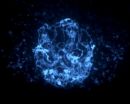Old star, new trick
2012-04-30
(Press-News.org) Pasadena, CA—The Big Bang produced lots of hydrogen and helium and a smidgen of lithium. All heavier elements found on the periodic table have been produced by stars over the last 13.7 billion years. Astronomers analyze starlight to determine the chemical makeup of stars, the origin of the elements, the ages of stars, and the evolution of galaxies and the universe. Now for the first time, astronomers have detected the presence of arsenic and selenium, neighboring elements near the middle of the periodic table, in an ancient star in the faint stellar halo that surrounds the Milky Way. Arsenic and selenium are elements at the transition from light to heavy element production, and have not been found in old stars until now.
Lead author of the Astrophysical Journal paper, Fellow Ian Roederer of the Carnegie Observatories explained: "Stars like our Sun can make elements up to oxygen on the periodic table. Other more massive stars can synthesize heavier elements, those with more protons in their nuclei, up to iron by nuclear fusion—the process in which atomic nuclei fuse and release lots of energy. Most of the elements heavier than iron are made by a process called neutron-capture nucleosynthesis.
"Although neutrons have no charge, they can decay into protons after they're in the nucleus, producing elements with larger atomic numbers. One of the ways that this method can work is by exposure to a burst of neutrons during the violent supernova death of a star. We call this process the rapid process (r-process). It can produce elements at the middle and bottom of the periodic table—from zinc to uranium—in the blink of an eye."
Roederer, with co-author James Lawler, looked at an ultraviolet spectrum from the Hubble Space Telescope public archives to find arsenic and selenium in a 12 billion year-old halo star dubbed HD 160617. These elements were forged in an even older star, which has long since disappeared, and then—like genes passed on from parent to infant—they were born into the star we see today, HD 160617."
The team also examined data for this star from the public archives of several ground-based telescopes and were able to detect 45 elements. In addition to arsenic and selenium, they found rarely seen cadmium, tellurium, and platinum, all of which were produced by the r-process. This is the first time these elements have been detected together outside the Solar System. Astronomers cannot replicate the r-process in any laboratory since the conditions are so extreme. The key to modeling the r-process relies on astronomical observations.
"What I find exciting is that arsenic and selenium can be found in other stars, even ones like HD 160617 that we've been studying for decades," remarked Roederer. "Now that we know where to look, we can go back and study these elements in other stars. Understanding the r-process helps us know why we find certain elements like barium on Earth, or understand why uranium is so rare."
INFORMATION:
The paper is published in the May 1, 2012 issue. Ian Roederer is supported by the Carnegie Institution through the Carnegie Observatories Fellowship. James Lawler is supported by NASA grant NNX10AN93G.
The Carnegie Institution for Science (CarnegieScience.Edu) is a private, nonprofit organization headquartered in Washington, D.C., with six research departments throughout the U.S. Since its founding in 1902, the Carnegie Institution has been a pioneering force in basic scientific research. Carnegie scientists are leaders in plant biology, developmental biology, astronomy, materials science
END
ELSE PRESS RELEASES FROM THIS DATE:
2012-04-30
Evidence that a Florentine merchant house financed the earliest English voyages to North America, has been published on-line in the academic journal Historical Research.
The article by Dr Francesco Guidi-Bruscoli, a member of a project based at the University of Bristol, indicates that the Venetian merchant John Cabot (alias Zuan Caboto) received funding in April 1496 from the Bardi banking house in London.
The payment of 50 nobles (£16 13s. 4d.) was made so that 'Giovanni Chabotte' of Venice, as he is styled in the document, could undertake expeditions 'to go and find ...
2012-04-30
Theoretical physicist Ali Naji from the IPM in Tehran and the University of Cambridge, UK, and his colleagues have shown how small random patches of disordered, frozen electric charges can make a difference when they are scattered on surfaces that are overall neutral. These charges induce a twisting force that is strong enough to be felt as far as nanometers or even micrometers away. These results, about to be published in EPJ E (1), could help to understand phenomena that occurr on surfaces such as those of large biological molecules.
To measure the strength of the twist ...
2012-04-30
Lifting less weight more times is just as effective at building muscle as training with heavy weights, a finding by McMaster researchers that turns conventional wisdom on its head.
The key to muscle gain, say the researchers, is working to the point of fatigue.
"We found that loads that were quite heavy and comparatively light were equally effective at inducing muscle growth and promoting strength," says Cam Mitchell, one of the lead authors of the study and a PhD candidate in the Department of Kinesiology.
The research, published in the Journal of Applied Physiology, ...
2012-04-30
Ann Arbor, Michigan… Regional differences in rates of cardiac procedures have increased in Michigan over the past decade—not fully explained by differences in health risk factors, heart attack or cardiac mortality rates—according to a report released today by the Center for Healthcare Research & Transformation (CHRT). The report compares the state's hospital referral regions (HRRs) using claims data from Blue Cross Blue Shield of Michigan's (BCBSM's) under-65 commercial subscribers and Medicare data from The Dartmouth Atlas of Health Care in Michigan.
According to the ...
2012-04-30
Vitamin D may be known as the sunshine vitamin, but a new research report appearing in the Journal of Leukocyte Biology shows that it is more than that. According to the report, insufficient levels of vitamin D are related to a deficiency in our innate immune defenses that protect us from infections, neoplasias or autoimmune diseases. Since vitamin D levels decrease during autumn and winter when days are shorter and sunlight is relatively weak, this may explain why people are more prone to viral infection during these times. It also suggests that vitamin D supplementation, ...
2012-04-30
New research published online in the FASEB Journal suggests that a specific enzyme, called 5-lipoxygenase, plays a key role in cell death induced by microgravity environments, and that inhibiting this enzyme will likely help prevent or lessen the severity of immune problems in astronauts caused by spaceflight. Additionally, since space conditions initiate health problems that mimic the aging process on Earth, this discovery may also lead to therapeutics that extend lives by bolstering the immune systems of the elderly.
"The outcomes of this space research might be helpful ...
2012-04-30
Scientists of KIT and the University of Birmingham have identified relevant new functions of a gene that plays a crucial role in Fanconi anemia, a life-threatening disease. The FANCM gene is known to be important for the stability of the genome. Now, the researchers found that FANCM also plays a key role in the recombination of genetic information during inheritance. For their studies, the scientists used thale cress as a model plant. Their results are newly published by the journal The Plant Cell.
Stability of the genome is ensured by a series of mechanisms. If these ...
2012-04-30
Are you connected to college friends on Facebook? Research from North Carolina State University shows that these social networks tend to form around graduation year or university housing – rather than other interests.
Researchers examined the first 100 colleges and universities to have students, faculty or staff join Facebook when the site exclusively contained .edu email addresses. As students, faculty and staff joined Facebook, social networks were formed. Each university, in essence, formed its own network – ranging in size from 762 to 50,000.
"We wanted to see what ...
2012-04-30
Removing a child's ruptured appendix sooner rather than later significantly lowers hospital costs and charges, according to a recently published study.
An estimated $10,000 in hospital charges was saved when pediatric general surgeons removed the ruptured appendix within the first 24 hours, compared to the alternative treatment, called an interval appendectomy, which involved removing the appendix six-eight weeks later.
The study was published in the April issue of the Journal of American College of Surgeons, and was led by Martin Blakely, M.D., MS, associate professor ...
2012-04-30
WEST LAFAYETTE, Ind. - Today's hybrid corn varieties more efficiently use nitrogen to create more grain, according to 72 years of public-sector research data reviewed by Purdue University researchers.
Tony Vyn, a professor of agronomy, and doctoral student Ignacio Ciampitti looked at nitrogen use studies for corn from two periods -- 1940-1990 and 1991-2011. They wanted to see whether increased yields were due to better nitrogen efficiency or whether new plants were simply given additional nitrogen to produce more grain.
"Corn production often faces the criticism from ...
LAST 30 PRESS RELEASES:
[Press-News.org] Old star, new trick

